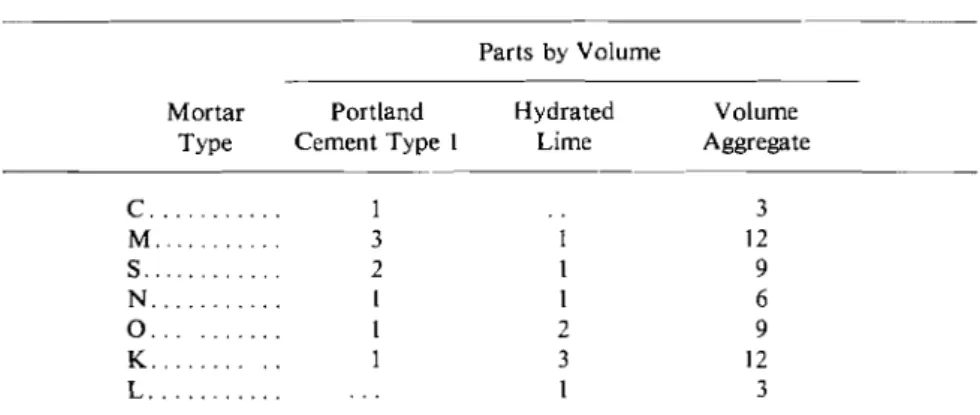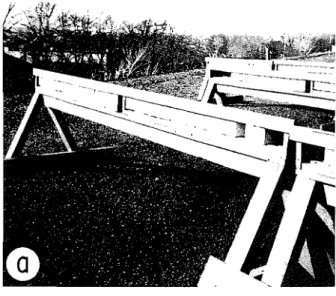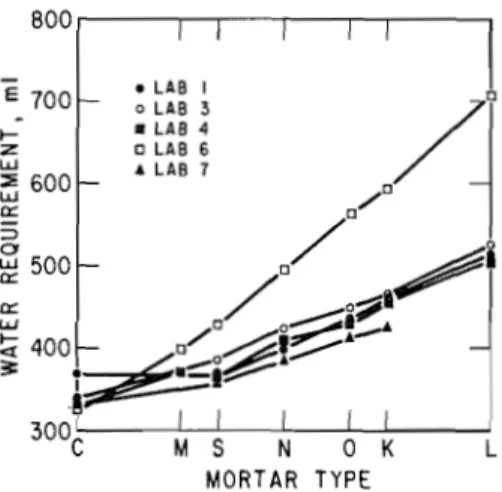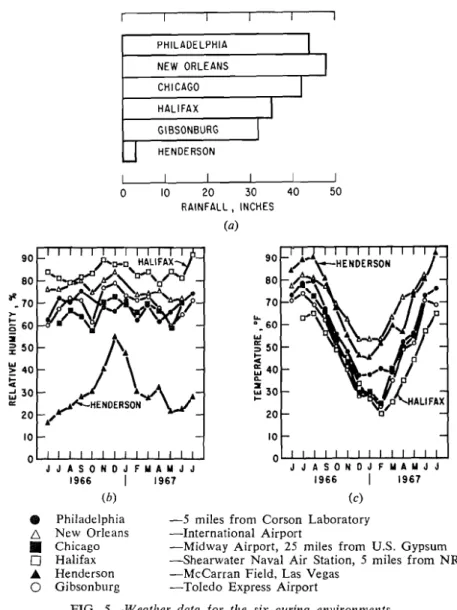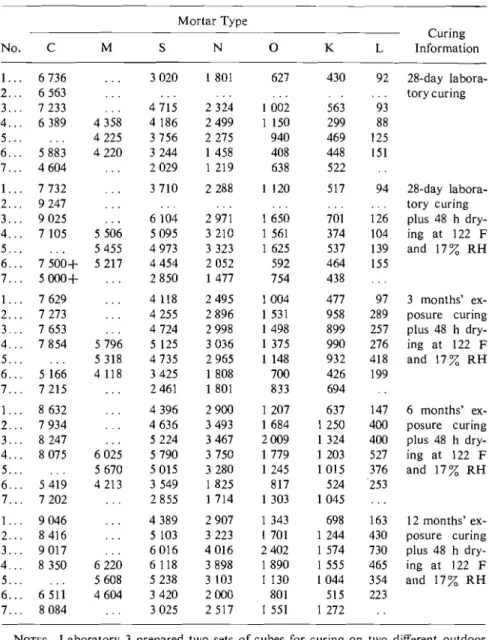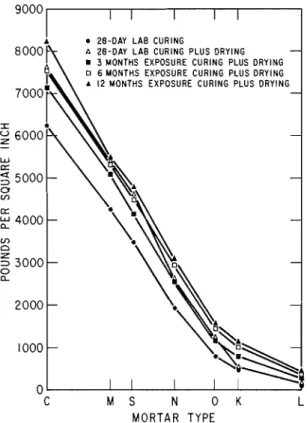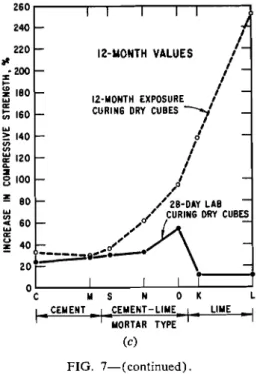Publisher’s version / Version de l'éditeur:
ASTM Special Technical Publication, 472, pp. 193-208, 1970-04-01
READ THESE TERMS AND CONDITIONS CAREFULLY BEFORE USING THIS WEBSITE.
https://nrc-publications.canada.ca/eng/copyright
Vous avez des questions? Nous pouvons vous aider. Pour communiquer directement avec un auteur, consultez la première page de la revue dans laquelle son article a été publié afin de trouver ses coordonnées. Si vous n’arrivez pas à les repérer, communiquez avec nous à PublicationsArchive-ArchivesPublications@nrc-cnrc.gc.ca.
Questions? Contact the NRC Publications Archive team at
PublicationsArchive-ArchivesPublications@nrc-cnrc.gc.ca. If you wish to email the authors directly, please see the first page of the publication for their contact information.
NRC Publications Archive
Archives des publications du CNRC
This publication could be one of several versions: author’s original, accepted manuscript or the publisher’s version. / La version de cette publication peut être l’une des suivantes : la version prépublication de l’auteur, la version acceptée du manuscrit ou la version de l’éditeur.
Access and use of this website and the material on it are subject to the Terms and Conditions set forth at
Curing of cement-lime mortars
Davison, J. I.
https://publications-cnrc.canada.ca/fra/droits
L’accès à ce site Web et l’utilisation de son contenu sont assujettis aux conditions présentées dans le site LISEZ CES CONDITIONS ATTENTIVEMENT AVANT D’UTILISER CE SITE WEB.
NRC Publications Record / Notice d'Archives des publications de CNRC:
https://nrc-publications.canada.ca/eng/view/object/?id=6ceb0bcd-091d-4e28-b326-0b17f7dc6da3 https://publications-cnrc.canada.ca/fra/voir/objet/?id=6ceb0bcd-091d-4e28-b326-0b17f7dc6da3REFERENCE: Davison, J. I., "Curing of Cement-Lime Mortars," The Reaction Parameters o f Lime, ASTM STP 472, American Society for Test- ing and Materials, 1970, pp. 193-208.
ABSTRACT: Masonry mortars are assessed o n the basis of tests on specimens prepared and cured in the laboratory. Curing procedures differ depending o n the relative amounts of cement and lime in the mortar, and the relation between the end result and that attained in the field, where n o concession is made for the composition of the mortar, is often questioned. Laboratory and outdoor curing of a series of cement-lime mortars were compared on the basis of compressive strength values. Outdoor curing refleots a variety of weather conditions typical of six geographical areas of the continent. Results indicate increasing discrepancies in values as the amount of cement in the mortars was decreased and the lime increased. Drying laboratory cured cubes before testing substantially reduced these discrepancies for cement and cement-lime mortars, but values for laboratory cured lime mortars remained well below those cured outdoors.
KEY WORDS: curing, environments, weather, laboratories, carbonation, moisture, mortars (material), cements, calcium oxide, compressive strength, assessments, evaluation, tests
The first recorded use of lime in masonry mortar was in the building of the Egyptian pyramids between 4000 and 2000 B.C.* From that time until the beginning of the present century lime remained the basic cementitious material in mortar.
Soon after the introduction of portland cement during the early part of the entieth century, it was found that the addition of cement accelerated
Y"
the curing process and provided the high early strength now required by
*
This paper is a contribution from the Division of Building Research, National Research Council of Canada, and is presented with the approval of the director of the division.' Research officer, Atlantic Regional Station, Division of Building Research, National Research Council of Canada, Halifax, N. S., Canada.
? Boynton, R. D., Chemistry and Technology o f Lime and Limestone, Interscience,
194 THE REACTION PARAMETERS OF LIME
the construction industry. The trend to replace lime with cement continued until, in the early 1930's, serious moisture penetration problems were en- countered in masonry walls in which predominantly cement mortars had been used.
Since that time mortars containing lime and cement in varying propor- tions have been used extensively. These mortars combine two materials, each with desirable properties to contribute to the end product. Cement adds strength, particularly early strength, to the slow-setting lime mortars. Lime adds workability and good water retentivity to the harsh cement mortars, properties essential in ensuring maximum bond with the masonry units. Cement-lime mortars give the architect maximum versatility. He can adjust the cement and lime contents to meet his requirements: high strength on the one hand and the ultimate in workability and extent of bond on the other.
For an assessment of the relative merits of the various cement-lime mortars, the architect relies on laboratory tests described in mortar specifi- cations, such as ASTM Specification for Mortar for Unit Masonry ( C 270). Many students of masonry have observed that current laboratory curing procedures do not reflect adequately the end result attained in the field with mortars containing high percentages of lime. The excellent durability of lime mortars, as evidenced by the performance of many old buildings (for example, Independence Hall in Philadelphia) along the northeast coast of the Continent, would not be predicted on the basis of laboratory test results. Staley3 noted an increasing discrepancy in the ratio of compressive strength values for cylinders, cured 6 months and 28 days, as the percentage of lime increased in cement-lime mortars. Others have4 noted the lack of a satisfactory method for curing cement-lime mortars and suggested an accelerated curing in a carbon dioxide (CO?) atmosphere.
Interest in improving curing procedures for mortars containing lime, in ASTM Committee C-7, resulted in a preliminary study to compare current laboratory procedures with outdoor curing. The program, which was de- veloped in the Research Subcommittee of Committee C-7 and coordinated in the DBR Atlantic Regional Laboratory of the National Research Coun- cil of Canada, compares the two methods of curing on the basis of com- pressive strength values for 2-in. mortar cubes. There were five partic- ipants, and they provided outdoor curing e?&onments typical of six widely separated locations on the North American continent.
"taley, H. R., "Volume Changes in Mortars and Strength Characteristics of Brick Masonry," Proceedings, National Lime Association, Washington, D. C., 1939, pp. 37-65.
TABLE I-Mortar proportiotls by volume.
Parts by Volume
Mortar Portland Hydrated Volume
Type Cement Type 1 Lime Aggregate
The Mortare
The mortars included in the study are listed in Table 1. In addition to the five mortars listed in ASTM Specification C 270, two others, a 1 :3 cement:sand, and a 1 : 3 1ime:sand mortar are included. All participants used cement and lime available in their respective areas. All used hydrated lime; one participant also included a lime putty. The hydrated limes were all dolomitic; the lime putty was high calcium. The aggregate was a combi- nation of equal parts graded and 20:30 Ottawa sand. The mixing of the mortars and the molding of the cubes followed procedures outlined in ASTM Specification C 270-64 T, with the following exceptions: ( 1 ) the weight of hydrated lime used in calculations to determine the amount to be used was taken as 5 0 lb/ft3 ( a recommendation from ASTM Committee C-7); and ( 2 ) the waiting period as stated in Section 6. Subsection 5, was increased from 1Yz to 3 min. Thirty-six cubes were molded for each mor- tar. As the cubes were removed from the molds they were numbered; one- third (12 cubes) were designated for laboratory curing and the remaining two-thirds (24 cubes) for outdoor curing. The numbering and selection of the cubes was done according to a predetermined pattern carefully set out in the instructions.
Curing Procedures
Laboratory
Laboratory curing was of 28 days' duration and followed the procedures designated in ASTM Specification C 270-64 T.
Types C , M , and S-The "cement" mortars. After molding, these cubes were kept in molds in a moist cabinet maintained at a relative humidity of 90 percent or more for 48 to 52 h. After their removal from the molds,
those cubes designated for laboratory curing were returned to the moist cabinet. At the end of seven days they were immersed in clean water where they remained for the duration of the curing period.
T y p e s N and 0-The "cement-lime" mortars. After being molded these cubes also were placed in the moist cabinet for 48 to 52 h. Upon removal from the molds the cubes designated for laboratory curing were returned to the moist cabinet for the duration of the curing period.
T y p e s K and L-The "lime" mortars. After being molded these cubes were left in molds in laboratory air at a temperature of 70 k 5 F for 48 to 52 h, and after their removal from the molds they were stored in the laboratory air for the entire curing period.
All cubes designated for outdoor curing were placed on an exposure site in wooden shelters facing toward the south immediately after their removal from the molds. The shelters (Figs. 1 and 2) were designed in such a way that five sides of the cubes were protected, while the sixth side was exposed to the weather. The design also permitted free circulation of air around the cubes. The shelters were supported on frames 18 in. above ground level to prevent their being buried in snow. Outdoor curing periods were three months, six months, and one year.
I{ PLYWOOD
END DETAIL OF
SHELTER 2 SHELTERS ON
1 5 4 x 251; SPRUCE APPROX. 3 6 ' ~ ~ .
FIG. 2-c;bes c~trirzg on e.rposttre site: ( a ) close-up of sllelter and rack; ( b ) general view.
Compressive Strength Tests
ASTM Specification C 270-64 T directs that compressive strength tests be conducted on cubes in the condition in which they were cured. Thus rhe cement mortars (Types C , M, and S ) are tested wet, the cement-lime mortars (Types N and 0) are tested damp, and the lime mortars (Types
1 98 THE REACTION
PARA METE^^
OF LIMEK and L ) are tested air dry. This procedure was questioned on the grounds that results would not be comparable. It was noted also that the moisture content of cubes removed from the outdoor curing site for testing would vary with weather conditions at the end of the respective curing periods. Therefore, it was decided to test all cubes in an oven-dry condition and to compare the results with those for laboratory-cured cubes tested, as directed, in their as-cured condition. Thus, half the laboratory-cured cubes were tested in the normal manner, while the remainder and all the outdoor cured cubes were dried upon completion of the curing period and prior to compressive strength tests.
The procedure outlined in ASTM Test for Drying Shrinkage of Concrete Block ( C 426-66T) was selected for drying the cubes. Although this pro- cedure applies specifically to concrete blocks, it was selected because it was adequate for the study, and it seemed more,logical to use a recognized ASTM test rather than draw up a new one. Under its provisions, the cubes were dried in an oven for 48 h at a temperatufe of 122 2 2 F and a rela- tive humidity of 17 '-2 percent. The cubes were then cooled to room tem- perature (70 '-5 F ) and compressive strength tests carried out. The cubes tested in the dry condition were thus two days older than the indicated curing period, that is, laboratory-cured cubes tested dry were tested at 28 + 2 days and compared with as-cured cubes tested at 28 days.
Variables
There were a number of major variables in the program that should be recognized before considering the re'sults:
1. The use of different cement and lime by each participant. This was not considered important as the object of the study was a comparison of curing procedures and. not absolute values.
2. An unexpected variable, as a result of variable No. 1, appeared in the form of a range in the water requirements for each mortar in the dif- ferent laboratories. The differences can be seen in Fig. 3 where the amounts of water required to produce a flow of 110 to 115 percent are shown. It will be noted that results from Laboratory 6 were quite different than those from the other laboratories. This appears to relate to the lime since the water requirement for the cement mortar was similar to the other laboratories, and the discrepancy widened as the percentage of lime in the mortar was increased.
3. A third major variable was the weather conditions which governed the outdoor curing, and reflected typical conditions in various parts of the continent: Henderson, Nev.; Chicago, Ill.; Gibsonburg, Ohio; New Or- leans, La.; Philadelphia, Pa.; and Halifax, Canada (Fig. 4 ) . Records of
-
€- 'OOt
w L A B I I o L A B 3 I- L A B 4 z o L A B 6 M O R T A R T Y P EFIG. 3-Water required to produce mortars in f l o ~ ratzge 110 to 115 percent.
monthly average temperature, relative humidity, and rainfall were compiled from weather summaries published by meteorological stations nearest the exposure sites and are plotted in Fig. 5. The data indicate that: (a) highest relative humidity occurred at Halifax and by far the lowest at Henderson;
( b ) Highest temperatures occurred at Henderson and New Orleans. In New Orleans the high temperatures were associated with the second highest relative humidity. Lowest temperatures were recorded at Halifax; (c) Lowest rainfall totals were at Henderson. The most distinctive features of the weather data are the low rainfall and humidity recorded at Henderson.
200 THE REACTION PARAMETERS O F LIME PHILADELPHIA
I
NEW ORLEANS CHICAGO HALIFAXI
GIBSONBURG HENDERSON I I I I I I 0 10 2 0 30 4 0 5 0 RAINFALL, INCHES (a) 9 0 8 0 7 0"
6 0 w 5 0 4 4 0 P 3 0 2 0 10 0 J J A S O N D J F Y A Y J J J J A S O N O J F Y A Y J J 1966 1 1967 1966 1 1967 ( 6 ) ( c )Philadelphia -5 miles from Corson Laboratory New Orleans -International Airport
Chicago -Midway Airport, 25 miles from U.S. Gypsum Halifax -Shearwater Naval Air Station, 5 miles from NRC A Henderson -McCarran Field, Las Vegas
0 Gibsonbnrg -Toledo Express Airport
FIG. 5-Weather data for the six curing environments.
Results
Average values obtained by each laboratory for the different mortars are shown in Table 2. The overall averages, listed in Table 3 and shown graphically in Fig. 6, reveal large differences in values for the different laboratories. Contributing to these differences are the major variables listed above plus the inevitable variations in laboratory techniques despite the use of uniform procedures.
TABLE 2-Comnpressive strerlgtlr valrres (psi) ir~rlivid~ral laboratory averages. -- -Mortar Type Curing No. C M S N 0 K L Information I . . . 6736 . . . 3020 1801 627 430 92 28-day labora- 2 . . . 6563 . . . . . . . . . . . . . . . . . tory curing 3 . . . 7 2 3 3 . . . 4 715 2 324 1002 563 93 4 . . . 6 389 4 358 4 186 2 499 1 150 299 88 5 . . . . . . 4 2 2 5 3756 2 2 7 5 940 469 125 6 . . . 5883 4 2 2 0 3244 1 4 5 8 408 448 151 7 . . . 4604 . . . 2029 1 2 1 9 638 522 . . I . . . 7732 . . . 3710 2288 1 1 2 0 517 94 28-day labora- . . . 2 . . . 9247 . . . . . . . . . . . . . . . tory curing 3 . . . 9 0 2 5 . . . 6 104 2971 1650 701 126 plus 48 h dry- 4 . .
.
7 105 5 506 5 095 3 210 1 561 374 104 ing at 122 F . . . 5 . . . 5455 4973 3323 1 6 2 5 537 139 a n d 1 7 z R H 6 . . . 7500+ 5217 4454 2052 592 464 155 7 . . . 5OOO+ . . . 2850 1 4 7 7 754 438 . . . I . . . 7629 . . . 4118 2495 1004 477 97 3 months' ex- 2 . . . 7273 . . . 4 255 2 896 1 531 958 289 posure curing 3 . . . 7 6 5 3 . . . 4 724 2 998 1 498 899 257 plus 48 h dry- 4 . . . 7854 5 7 9 6 5 1 2 5 3036 1 3 7 5 990 276 ing at 122 F 5 . . . . . . 5318 4735 2965 1148 932 418 and 1 7 z R H 6 . . . 5166 4118 3425 1 8 0 8 700 426 199 7 . . . 7 215 . . . 2 461 1 801 833 694 I . . . 8 632 . . . 4 396 2 900 1 207 637 147 6 months' ex- 2 . . . 7934 . . . 4 636 3 493 1 684 1250 400 posure curing 3 . . . 8247 . . . 5 224 3 467 2 009 1 324 400 plus 48 h dry- 4 . . . 8075 6025 5790 3750 1 7 7 9 1 2 0 3 527 i n g a t 122 F 5 . . . . . . 5670 5 0 1 5 3280 1245 1 0 1 5 376 a n d 1 7 z R H 6 . . . 5 419 4 213 3 549 1825 817 524 253 7 . . . 7202 . . . 2 855 1714 1 303 1 0 4 5 . . . I . . . 9046 . . . 4 389 2 907 1 343 698 163 12 months' ex- 2 . . . 8 416 . . . 5 103 3 223 1 701 1 244 430 posure curing 3 . . . 9017 . . . 6016 4 016 2 402 1 574 730 plus 48 h dry- 4 . . . 8 350 6 220 6 118 3 898 1 890 1 555 465 ing at 122 F 5 . . . . . . 5608 5238 3103 1130 1044 354 a n d 1 7 Z R H 6 . . . 6511 4604 3420 2000 801 515 223 7 . . . 8084 . . . 3025 2517 1551 1272 . .NOTES-Laboratory 3 prepared two sets of cubes for curing on two different outdoor sites; these values are listed as Nos. 2 and 3. Laboratory-cured values are listed under No. 3.
Laboratory 4 prepared two sets of cubes, one set of mortars containing hydrated lime (No. 4), the other set containing lime putty (No. 5).
Only Nos. 4, 5, and 6 included Type M mortar in their program. No. 7 did not test a Type L mortar.
w
m
TABLE 3-Surnmary of average compressive srret~grh values (psi).
2
.
,- 2
0
Improve- Improve- Irnprove- Improve- z
rnent rnent rnent ment -u
Type of Mortar A B B over A, % C Cover A, % D D over A, % E E over A, %
.
-p-p.
E
-l
C 1:3cernent:sand.. . 6235 7 601+ 21.9 7 132 14.4 7 585 21.6 8 237 32.1 rn w m
NOTE-A. 28-day laboratory curing.
B. 28-day laboratory curing plus 48 h drying at 122 F and 17% RH. C. 3 months' exposure curing plus 48 h drying at 122 F and 17% RH.
D. 6 months' exposure curing plus 48 h drying at 122 F and 17% RH.
28-DAY LAB CURING
A 28-DAY L A B CURING P L U S DRYING 3 MONTHS EXPOSURE CURING PLUS DRYING 0 6 MONTHS EXPOSURE CURING PLUS DRYING
0 a 2000 - I000 - C M S N O K L M O R T A R TYPE
FIG. 6-Compressive strength values after differer~r curing periods.
Lqboratory Curing
Thgre were great differences between the compressive strength values for the as cured and the dry cubes. Drying the wet cement mortars (Types C, M, and S) resulted in increases of 21.9, 26.4, and 29.7 percent of the as cured values. The biggest increases-32.3 and 53.3 percent-occurred with the cement-lime mortars (Types N and O ) , while the effect of dry- ing was much less for the air-cured lime mortars (Types K and L) (Fig. 7 ) .
Weight losses were checked in the control laboratory and results (Table 4 ) show that the moist cement-lime mortars contained mcre water than the wet cement mortars. Increasing weight losses in mortars Types C through 0 suggests an increasing capacity to hold water as the pore volume in- creases with increasing lime content. In addition, apparently the conditions of moist curing, at least in the control laboratory, were sufficient to main- tain a high level of saturation in the pores of the cement-lime cubes. The
3-MONTH VALUES 3-MONTH EXPOSURE,'
U
I I I I I
C M S N O K L
CEMENT I _CEMENT-LIME I LlME _I
I MORTAR TYPE I
-
( a )
FIG. 7-Conipnrisorz o f compressive sirengil~ vnl~res fo r different c~rrirtg periods.
2 2 0
*
2 0 0$
1 8 0 2 p I 6 0 C '0 140 2 2 I 2 0 W K 2 100- opattern of increasing weight losses on drying was broken by air curing for the lime mortars. Figures indicate that they contained very small amounts of moisture. I I I I I 6
-
-
6-MONTH VALUES1-
f I-
-
f f-
'
-
6-MONTH EXPOSURE'
-
CURING DRY CU8ES-
I
-
28-DAY LAB I
Outdoor Curing-Three Months
8 0 - I
-
I w 6 0-
-
'0 a 4 0 --
U-
I n I I II T
Increases in the values for dry cubes after three months of outdoor cur- ing over 28-day laboratory-cured cubes tested in the as cured condition are shown in Figs. 6 and 7. The data indicate an increasing improvement as the amount of lime in the mortars is increased. The pattern changes if the comparison is made against the values for cubes dried before testing after
FIG. 7-(continued). 2 6 0 240 220 Z ; 200 + (D 2 180 Y a k 160 Y
2
140 In,w
120 xs
I 0 0 B O - Y ~n 5 6 0 a 4 0 - 2 0 028 days' laboratory curing. In this case the values for the three-month cubes are below the 28-day cubes for mortar Types C to 0, with the ex- ception of Type N, where they are about equal. There is a sharp increase in values for the lime mortars (Types K and L) over the 28-day dry values. Thus the results suggest that laboratory curing is superior to three months of exposure curing for cement and cement-lime mortars, but that it is inferior for lime mortars.
TABLE 4- Weigl~t losses it1 mortar cubes ( % dry weight) after drying for 48 11 at 122 zt 2 F atld 17 f: 2% RH deternlined it1 cot~trol
laboratory.
I 1 I I I
-
Laboratory Outdoor Curing Mortar Curing,
Type 28 Days 3 Months 6 Months I Year
-
12-MONTH VALUES
-
i
-
-
12-MONTH EXPOSURE
1 -
-
CURING DRY CUBES-
7
'
-
-
'
-
Ild
I-
d
-
J8' J 20-DAY LAB-
/
CURIN6 DRY CUBES-
-
-
: : > a - I..q
I I I 0 I-
, I C M S N O K LOutdoor Curing-Six Months
Increases in the values for mortars after six months of outdoor curing over values for as cured mortars at 28 days are shown also in Figs. 6 and 7. There is a continuing and growing improvement over the original values as the percentage of lime in the mortars increases, as was noted in values for the three-month cubes. The increases range from 22 percent for Type C (cement) mortar to 212 percent for Type L (lime) mortar. When the comparison is made against values for dry cubes at 28 days, the values for cement mortars are about equal, but outdoor curing resulted in an 18 to 35 percent improvement for the cement-lime mortars and 110 to 200 percent for the lime mortars.
Outdoor Curing-Twelve Months
The trends noted above continue as the values of mortars cured outdoors for twelve months are compared with mortars cured in the laboratory and tested in the as cured condition (Figs. 6 and 7 ) . There are increasing im- provements as the amount of lime in the mortars is increased. If the com- parison is made with the values for dry cubes at 28 days, all the mortars have improved beyond their original values. The cement mortars show an increase of 2 to 10 percent, the cement-lime mortars have increased 28 to 41 percent, and the lime mortars 137 to 141 percent.
Results for the twelve-month outdoor-cured mortars indicate a reduc- tion in the curing rate for cement-lime and lime mortars in the six to twelve-month period as compared with the rate during the three to six- month period. This was not as evident for the cement mortars (except Type M where there were only three values). I t should be noted that the six-month to one-year period included the winter months, and the slow- down in the curing rate during this period may reflect, in part, the adverse effect of winter weather conditions on the curing of the lime portion of the mortar.
Discussion
It is important to be realistic when considering the extent to which laboratory curing of masonry mortars should reflect the end result achieved in the field. Certainly laboratory curing of lime mortars cannot be expected to approach the condition of the mortar in buildings like Independence Hall. Lime cures very slowly by reacting with the C 0 2 in the air, and its ultimate strength is not attained for many years. But the architect must specify a mortar that will acquire the strength required when the building is ready to assume its full load. In discussing this aspect, Voss%uggests
" Voss, W. C.. "Exterior Masonry Construction," B~clletin 324, National Lime
that "occupancy involving the full loads of design is usually delayed by at least six months from the time of laying." It was probably on this basis that Staley compared compressive strength values for mortars cured six months with those cured 28 days. A comparison of his results with those obtained in the present study is as follows:
--
6 Month/28 Day Ratio
The same pattern of increasing discrepanices, in the six-month/28-day ratio, as the lime content of the mortars is increased, occurs in results of this study as observed by Staley, although the differences are not as great. Most significant, however, are the figures in the column comparing the six- month values with those for dry cubes at 28 days: the 28-day laboratory results equal those for the six-month cement mortar, but the increases in the 1 : 1 : 6 and 1 :
2:
9 cement-lime mortars have been reduced sharply. The big increases remain with the lime mortars where, as noted previously, drying has no appreciable effect.The weight loss data in Table 4 indicate that cement and cement-lime mortars cured on outdoor exposure had much lower moisture contents than those cured in the laboratory, while lime mortars were slightly higher. It is noted also that moisture contents generally became smaller as the curing period was lengthened. A notable exception to this is the value 6.9 percent for Type 0 mortar after six months' outdoor curing. I t was raining on the day these cubes were removed from the exposure site, and had the cubes been tested in their as cured condition the resulting value would not have been representative. Drying the cubes eliminated the possibility of in- consistencies of this type. Weight loss data, as previously noted, indicate that cement-lime mortars remain near saturation during moist cabinet cur- ing. The result of curing at lower relative humidities that would allow some air to enter the pore spaces and facilitate a more extensive carbonation of the lime might be studied.
Staley
Mortar
ASTM Committee C-7
Laboratory Cubes Laboratory Cubes
208 THE REACTION PARAMETERS O F LIME
Conclusions
Compressive strength values for mortars cured outdoors show increasing discrepancies, when compared with values for mortars cured and tested by conventional laboratory methods, as the percentage of cement in the mortar is decreased and the percentage of lime is increased.
These discrepancies are reduced greatly if laboratory-cured cement and cement-lime mortar cubes are dried before testing.
Big differences remain between values for outdoor- and laboratory-cured lime mortars even when they are compared on the basis of values for cubes that have been dried before testing.
